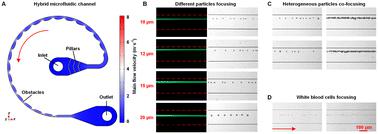Our official English website, www.x-mol.net, welcomes your
feedback! (Note: you will need to create a separate account there.)
Inertial co-focusing of heterogeneous particles in hybrid microfluidic channels with constantly variable cross-sections
Lab on a Chip ( IF 6.1 ) Pub Date : 2024-09-24 , DOI: 10.1039/d4lc00479e Tianwei Zhao, Peng Zeng, Yuanting Zhang, Jinxia Li, Hui Sun, Imrich Gablech, Honglong Chang, Xichen Yuan, Pavel Neužil, Jianguo Feng
Lab on a Chip ( IF 6.1 ) Pub Date : 2024-09-24 , DOI: 10.1039/d4lc00479e Tianwei Zhao, Peng Zeng, Yuanting Zhang, Jinxia Li, Hui Sun, Imrich Gablech, Honglong Chang, Xichen Yuan, Pavel Neužil, Jianguo Feng

|
Heterogeneous particles co-focusing to a single stream is a vital prerequisite for cell counting and enumeration, playing an essential role in flow cytometry and single-cell analysis. Microfluidics-based inertial focusing holds great research prospects due to its simplicity of devices, ease of operation, high throughput, and freedom from external fields. Combining microfluidic channels with two or more different geometries has become a powerful tool for high-efficiency particle focusing. Here, we explored hybrid microfluidic channels for heterogeneous particle co-focusing. Four different annular channels with obstacles distributed on the inner wall were constructed and simulated, obtaining constantly variable secondary flows. Then we used four different fluorescent particles with the size of 10 μm, 12 μm 15 μm, and 20 μm as well as their mixture to perform the inertial focusing experiments of multi-sized particles. Theoretical simulation and experimental results demonstrated a focusing efficiency of >99%. Finally, we further utilized human white blood cells to estimate the co-focusing performance of our hybrid microfluidic channel, resulting in a high focusing efficiency of >92% and a high throughput of ≈8000 cell s−1. The hybrid microfluidic channels, capable of high-precision heterogeneous particle co-focusing, could pave a broad avenue for microfluidic flow cytometry and single-cell analysis.
中文翻译:

异质粒子在具有恒定可变横截面的混合微流体通道中的惯性共聚焦
异质颗粒共聚焦到单个流中是细胞计数和计数的重要先决条件,在流式细胞术和单细胞分析中起着至关重要的作用。基于微流体的惯性聚焦由于其设备简单、易于操作、高通量和不受外部场的影响而具有很大的研究前景。将微流体通道与两个或多个不同的几何形状相结合已成为高效粒子聚焦的强大工具。在这里,我们探索了用于异质粒子共聚焦的混合微流体通道。构建并模拟了四个不同的环形通道,障碍物分布在内壁上,获得了不断变化的次级流。然后,我们使用 10 μm、12 μm、15 μm 和 20 μm 四种不同的荧光颗粒以及它们的混合物进行多尺寸颗粒的惯性聚焦实验。理论模拟和实验结果表明,聚焦效率为 >99%。最后,我们进一步利用人白细胞来估计我们的混合微流控通道的共聚焦性能,从而获得 >92% 的高聚焦效率和 ≈8000 个细胞 s-1 的高通量。能够高精度异质颗粒共聚焦的混合微流控通道可以为微流式细胞术和单细胞分析铺平广阔的道路。
更新日期:2024-09-24
中文翻译:

异质粒子在具有恒定可变横截面的混合微流体通道中的惯性共聚焦
异质颗粒共聚焦到单个流中是细胞计数和计数的重要先决条件,在流式细胞术和单细胞分析中起着至关重要的作用。基于微流体的惯性聚焦由于其设备简单、易于操作、高通量和不受外部场的影响而具有很大的研究前景。将微流体通道与两个或多个不同的几何形状相结合已成为高效粒子聚焦的强大工具。在这里,我们探索了用于异质粒子共聚焦的混合微流体通道。构建并模拟了四个不同的环形通道,障碍物分布在内壁上,获得了不断变化的次级流。然后,我们使用 10 μm、12 μm、15 μm 和 20 μm 四种不同的荧光颗粒以及它们的混合物进行多尺寸颗粒的惯性聚焦实验。理论模拟和实验结果表明,聚焦效率为 >99%。最后,我们进一步利用人白细胞来估计我们的混合微流控通道的共聚焦性能,从而获得 >92% 的高聚焦效率和 ≈8000 个细胞 s-1 的高通量。能够高精度异质颗粒共聚焦的混合微流控通道可以为微流式细胞术和单细胞分析铺平广阔的道路。


















































 京公网安备 11010802027423号
京公网安备 11010802027423号